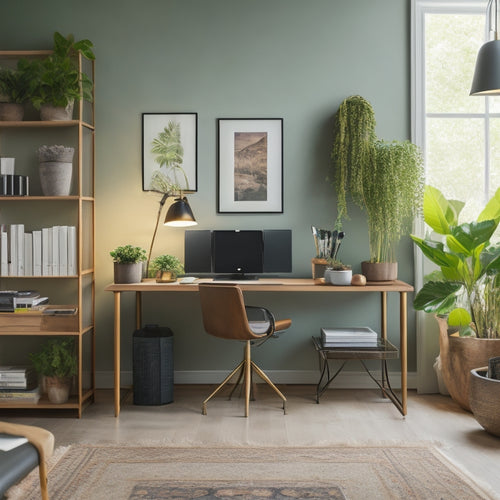
7 Steps to Paint Custom Cabinets Like Pro
Share
You'll achieve a professional-looking paint job on your custom cabinets by following seven essential steps. Start by preparing your cabinets for painting, including cleaning, degreasing, and sanding surfaces to guarantee a smooth finish. Remove hardware and fill any imperfections before creating a dust-free zone and applying primer. Next, select the right paint type and apply it with precision, considering factors like durability and finish. Add additional coats as needed, and seal your work with clear coat protection. With attention to detail and patience, you'll reveal a stunning, long-lasting finish. Now, get ready to take your cabinets to the next level.
Key Takeaways
- Proper preparation is crucial, including cleaning, degreasing, sanding, and filling imperfections to ensure a smooth, even finish.
- Choosing the right primer and paint is essential, considering factors like surface type, desired color, and durability requirements.
- Apply primer and paint in thin, uniform coats, following the wood grain, and work in manageable sections to maintain control.
- Additional coats may be necessary to achieve the desired color and finish, and clear coat protection adds durability and resistance to scratches and fading.
- Regular maintenance, including cleaning and inspection, is necessary to preserve the appearance and durability of custom-painted cabinets.
Prepare Cabinets for Painting
How thoroughly have you cleaned your cabinets before preparing them for painting? Cabinet cleaning is vital to guarantee a smooth, even finish.
Remove all items from your cabinets and wipe down shelves and walls with a gentle detergent. Use a degreaser to tackle tough grease and grime buildup.
To achieve a clutter-free environment that reflects your lifestyle needs, it's important to evaluate living spaces and identify areas for improvement. Don't forget to clean the exterior, including the frames and doors.
Next, remove all hardware, including knobs, handles, and hinges. Set aside screws and other small parts in a safe place. This will give you a clean slate for painting.
Failure to properly clean and prepare your cabinets can lead to uneven paint application, peeling, and other issues down the line.
Take the time to do it right – your cabinets will thank you.
Choose the Right Paint Type
Choosing the right paint type is crucial for achieving a durable, professional-looking finish on your custom cabinets.
You'll need to take into account the paint finish options, including matte, eggshell, satin, semi-gloss, and high-gloss. Each finish has its own benefits, such as durability, washability, and sheen level. For example, semi-gloss and high-gloss paints are ideal for high-traffic areas, while matte and eggshell paints are better suited for low-traffic areas.
Additionally, you'll need to make a paint color selection that complements the style and design of your cabinets. Take into account the color scheme of your kitchen, the type of lighting, and the overall aesthetic you want to achieve.
Sand and Clean Surfaces
You'll need to guarantee your cabinet surfaces are silky smooth before applying paint. Any imperfections or rough spots will show through the finish, so take the time to sand every surface thoroughly.
Next, create a dust-free zone by vacuuming or wiping down the cabinets to prevent particles from getting trapped in the paint.
Smooth Surfaces Matter
Preparing your custom cabinets for painting requires a precise approach, and it all begins with smooth surfaces. You want to guarantee that your cabinets are free of imperfections, dirt, and grime that can affect the finish quality of your paint job. Sanding and cleaning are vital steps in surface preparation, as they help create a strong bond between the paint and the surface.
| Surface Condition | Sanding Method | Cleaning Solution |
|---|---|---|
| Rough Wood | 80-grit sandpaper | TSP (Trisodium Phosphate) |
| Sanded Wood | 120-grit sandpaper | Mild dish soap |
| Previously Painted | 220-grit sandpaper | Denatured alcohol |
Dust-Free Zone Required
With your cabinet surfaces now smooth and ready, it's imperative to create a dust-free zone to secure a flawless paint job. You must take dust control seriously to guarantee a professional-looking finish.
Remove any dust or debris from the surrounding area, and cover your floors and furniture with drop cloths or plastic sheets. Use an air purifier or ventilation system to maintain good air quality, as airborne particles can settle on your cabinets and ruin the paint job.
Wipe down the cabinets with a tack cloth or a damp cloth to remove any remaining dust or dirt. Only then can you be confident that your paint will adhere properly and look its best.
Apply Primer for Best Results
Before applying the first coat of paint, prime your custom cabinets to guarantee a strong, durable bond between the surface and the paint.
You'll need to choose the right primer type for your cabinets' material. Oil-based primers work well on wood, while water-based primers are suitable for MDF or laminate.
Apply primer using a high-quality roller or brush, working in sections to maintain even coverage. Verify the primer is fully dry according to the manufacturer's instructions before moving on to the next step.
Proper primer application is essential, as it will affect the paint's adhesion and overall finish. Take your time, and don't rush this vital step.
Paint Cabinets With Perfection
Now that your custom cabinets are properly primed, you're ready to apply the first coat of paint. Choose a high-quality paint that matches your desired color selection, ensuring it's compatible with the primer.
Select the right brush techniques for your cabinet style: flat brushes for flat surfaces, angled brushes for corners, and round brushes for curved areas. Load the brush with the recommended amount of paint, and work in sections to maintain even coverage.
Apply the paint in thin, uniform coats, following the wood grain. Avoid overloading the brush, as this can lead to drips and unevenness.
Add Additional Coats Needed
After allowing the first coat to dry according to the manufacturer's instructions, inspect your custom cabinets for any areas that require additional coverage.
You may need to apply extra coats to achieve the desired color selection and finish options. Pay particular attention to areas with uneven color or sheen.
If you notice any imperfections, use a high-quality paintbrush or roller to apply additional coats, following the same application techniques as before.
Confirm each coat is dry before applying the next to prevent uneven buildup.
Seal With Clear Coat Protection
You'll want to seal your custom cabinets with a clear coat to protect the finish and enhance its appearance.
This step offers several benefits, including added durability and resistance to scratches and fading.
Clear Coat Benefits
When protecting your custom cabinets with a clear coat, the benefits are varied and vital to maintaining their appearance and durability. A clear coat creates a barrier against scratches, spills, and fading, ensuring your cabinets remain pristine for years to come.
You'll find various clear coat types, such as water-based, oil-based, and hybrid, each offering unique advantages. Choosing the right type depends on your cabinet material, desired finish, and environmental conditions.
Proper application methods, including spraying, brushing, or rolling, are essential to achieving a flawless finish. By applying a clear coat, you'll enjoy long-term protection, easy maintenance, and a professional-looking finish that enhances your cabinets' beauty.
Coat Application Tips
To guarantee a flawless finish, proper clear coat application is essential.
You'll want to choose the right tools for the job: high-quality brushes or rollers specifically designed for clear coat application.
For brush techniques, use gentle, even strokes to maintain a consistent coat thickness. Avoid applying too much pressure, which can create air bubbles or pooling.
For roller methods, use a foam roller to achieve a smooth, even finish. Work in small sections, about 4 feet by 4 feet, to maintain control and prevent drips.
Apply the clear coat in thin, uniform layers, allowing each layer to dry completely before applying the next.
Durability Matters
After applying the clear coat, your cabinet's finish is now vulnerable to damage from everyday wear and tear. To guarantee paint longevity, it's vital to seal your cabinets with a clear coat protection. This step is often overlooked, but it's fundamental in maintaining the appearance and durability of your custom cabinets.
| Material Selection | Durability | Reason |
|---|---|---|
| Polyurethane | High | Resists scratches and fading |
| Acrylic | Medium | Offers moderate protection |
| Lacquer | Low | Prone to yellowing and damage |
When choosing a clear coat, consider the material selection and its durability. Polyurethane provides high durability, while lacquer is more prone to damage. By selecting the right clear coat, you'll extend the life of your cabinets and maintain their appearance.
Frequently Asked Questions
Can I Paint Over Existing Cabinet Hardware or Must I Replace It?
You'll need to decide whether to paint over existing cabinet hardware or replace it, considering factors like hardware prep and ensuring proper paint adhesion; if the hardware is removable, take it off for a smoother finish.
How Do I Ensure Even Paint Distribution on Raised Cabinet Panels?
To guarantee even paint distribution on raised cabinet panels, you'll carefully prepare the surface by sanding and cleaning, then apply paint in thin, even coats, using a high-quality brush or roller specifically designed for smooth, consistent application.
Are There Any Specific Painting Techniques for Curved Cabinet Surfaces?
When tackling curved surfaces, you'll need to adapt your painting techniques to guarantee a smooth, even finish. Use specialized painting tools, such as flexible foam brushes or curved rollers, to maintain consistent contact and precise control.
Can I Use a Roller to Paint Cabinets or Just a Brush?
You'll achieve ideal results by combining roller application for flat areas with brush techniques for edges, corners, and intricate details, ensuring a smooth, even finish and precise control over paint distribution.
How Long Does It Take for Painted Cabinets to Fully Cure?
As you anxiously await the final reveal, remember that patience is a virtue: the curing time of your painted cabinets depends on paint types, with oil-based paints taking up to 30 days and water-based ones typically curing within 14-21 days.
Related Posts
-

Maximize Space With These Top Organization Apps
You're just a few clicks away from maximizing your space and time! Start by decluttering your digital life, then opti...
-

Boost Productivity With a Home Office Makeover
By altering your home office into a clutter-free, ergonomic, and inspiring space, you'll reveal your full productivit...

